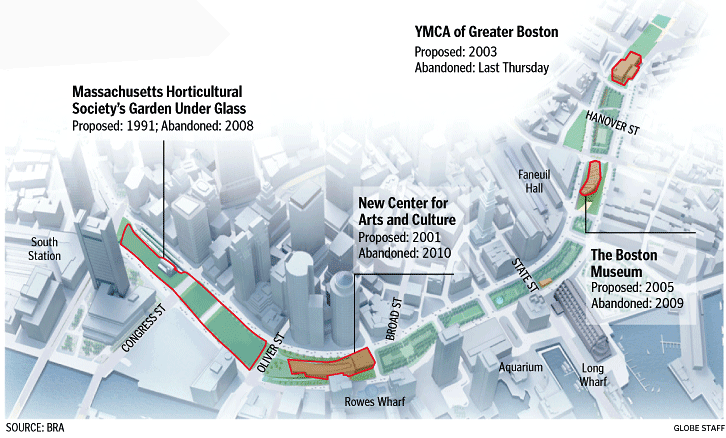 |
Franklin Street tower undergoing a makeover |
But with most of Verizon’s employees gone after a real estate consolidation, the so-called wedding cake style building is about to undergo a dramatic change. Its new owner begins a $35 million renovation next month that will add a large glass lobby on one side, and on the other, outdoor seating and space for restaurants and stores overlooking the park in Post Office Square.
“Our goal is to reintroduce a building that has been closed off for 50 years,’’ said Richard Galvin, president of Commonwealth Ventures, which was part of a group that bought the tower for $192 million in 2008. “Its front door is on one of the greatest public parks in America, and we want to celebrate that.’’
Galvin hopes the changes will attract tenants to fill the 400,000 square feet of office space left vacant by Verizon’s departure. The communications giant still leases space on the lower floors, but most of its employees moved out in November, opening space on floors 7 through 18.
In addition to its architectural style, the Franklin Street building was known for the striking 160-foot mural in its lobby, which pays homage to telephone operators who toiled there for decades. Verizon removed the mural at the owner’s request and is consulting with museums and other institutions to find a new location to display it.
Preservationists who initially raised concerns about the illustration’s removal say Galvin has worked closely with them to craft a renovation plan the emphasizes the building’s history.
“It’s one of the best examples of Art Deco that we have in the city,’’ Tony Fusco, president of the Art Deco Society of Boston, said of the tower. “It was built as a corporate headquarters for a historically important business in the region.’’
New England Telephone & Telegraph constructed the building in the late 1940s. In 1984, the company became Nynex. In 1997, it merged with Bell Atlantic, which eventually joined with GTE to create Verizon.
Commonwealth Ventures will rename the building 50 Post Office Square.
Galvin said many of the building’s original features will be preserved, including its high ceilings and the Maine granite that lines many hallways. Some of the elements sure to go are the floral drapes and orange carpeting that decorate the 18th-floor offices, which also contain fireplaces more typical of a country home than a downtown office tower.
The most significant changes will occur on the ground floor. A new exterior glass lobby designed by Elkus Manfredi Architects will replace a loading dock on High Street. The Franklin Street entrance will be fitted with large glass windows; this side of the building will also host two restaurants and a retail store. Tenants have not been named but the owners expect a financial services firm to occupy the retail space.
The renovation will add a 110-space parking garage in the basement and new lights to emphasize the wavy metal grillwork at the building’s apex.
Galvin’s primary challenge will be to find new office tenants in a sluggish real estate market. Demand and rents are on the rise, but nearly 20 percent of the office space in the Financial District is vacant, meaning he is competing with other landlords.
The building is being marketed by FHO Partners.
“I think we offer something different,’’ Galvin said, noting the building’s array of floor sizes could cater to large law firms or smaller financial companies. “The city does not have that many Art Deco buildings. It’s a design that inspires people.’’
Casey Ross Boston Globe February 24, 2011




